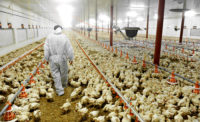Eagle Protect CEO Steve Ardagh shares some insights on the role proper PPE plays in a processing operation’s overall efficiency and safety efforts.
What role does proper PPE play in ensuring operational efficiency?
PPE covers a broad range of equipment and clothing, including helmets, jackets, eye coverings and masks that aid in the prevention of contamination and infectious diseases. One of the most essential PPE items that need to operate at the highest of standards are gloves.
Glove use is universal throughout food processing and foodservice. They are mandatory in multiple parts of the supply chain, and necessary for the health and safety of both workers and consumers. Gloves are a Zone 1 Food Contact Surface, and while they are extremely important, little thought is often given to their role in operational efficiency.
“Good gloves don’t rip!” Billions of gloves are wasted annually due to rips and tears, resulting in measurable inefficiencies. Examples include a poultry producer processing 130,000 birds per day who increased efficiency through proper fitting PPE, resulting in 15% more birds being processed daily. The company decreased worker absences from hand and arm injuries, saving over $400,000 annually. Other companies have reported reductions of up to 50% in their quantity of glove purchases due to buying better quality products.
Using cheap gloves made with substandard ingredients is false economy, leading to lower productivity, workers with illness or injury, consumers with contaminated products, and the risks of recalls, liability, and increased health care costs. Polluted water at manufacture is the principal cause of this glove contamination. The use of cheap and often toxic ingredients weakens gloves, leading to ripping.
Gloves are meant to protect, not infect. Poor quality gloves are a direct challenge to operational efficiency.
What regulatory guidance is influencing operational safety considerations for meat/poultry processors including PPE?
It’s more of a case of an absence of a vital piece of regulation. On the one hand, USDA Good Manufacturing Practices stipulate that gloves used by a substantial proportion of the 1.5 million workers in the meat, poultry, dairy, seafood, grain, bakeries, confectionary, and fruit and vegetable sectors, and a proportion of the 14 million workers in the food service sector, be “intact, clean, or sanitary.”
It is incumbent, therefore, on individual food processing and foodservice companies to self-regulate, to ask the right questions, to inquire into the manufacture of gloves, and to appreciate that “cheapest” is false economy.

.png?height=96&t=1647275041&width=96)



Report Abusive Comment